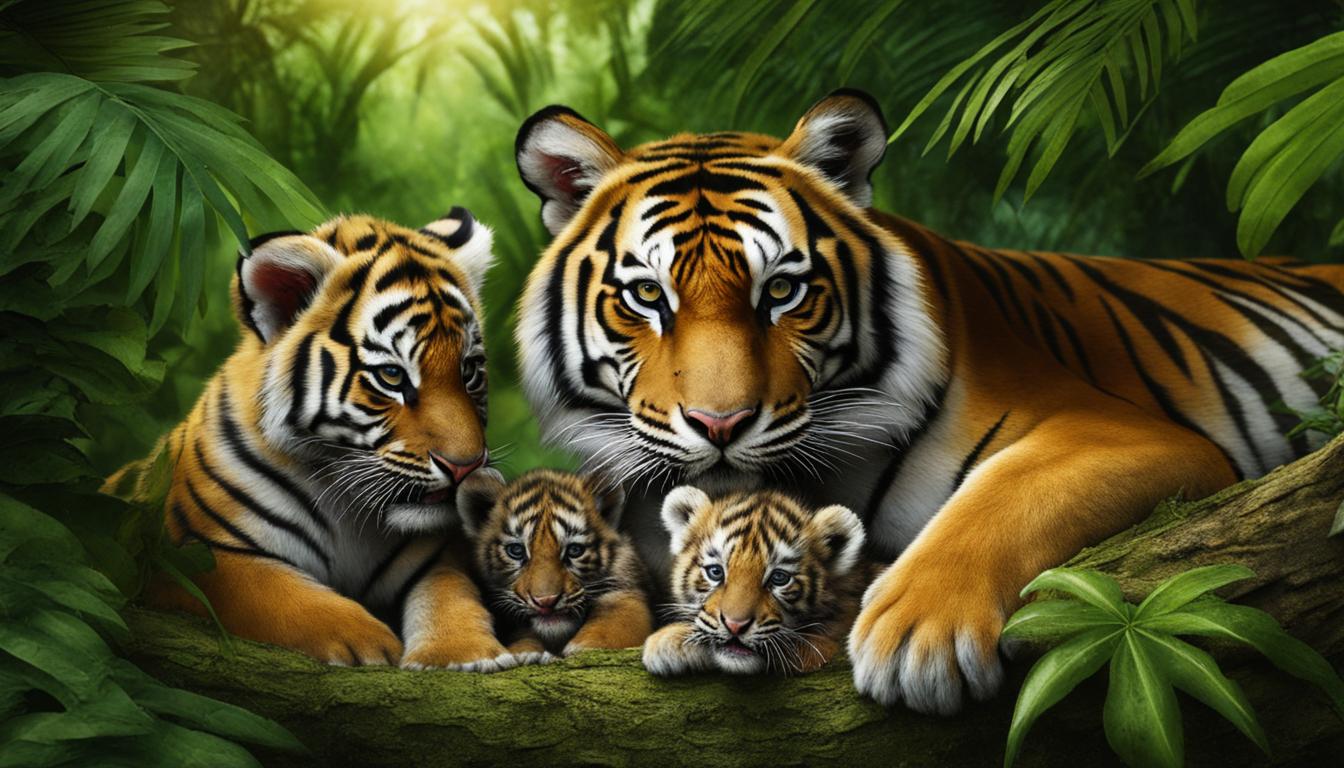Are you curious about the fascinating life cycle of tiger cubs? These adorable creatures go through a series of stages as they grow and learn valuable skills. From their blind and helpless beginnings to becoming independent hunters, tiger cubs have an incredible journey. Join us as we explore the life cycle of tiger cubs and discover how they learn to navigate their world.
Key Takeaways:
- Tiger cubs are born blind and dependent on their mother for survival.
- They gradually gain their vision and start exploring their surroundings at around one month old.
- The tigress is solely responsible for raising and caring for her tiger cubs.
- Tiger cubs learn important hunting skills by observing their mother and participating in play-fights with their siblings.
- Understanding the life cycle and learning habits of tiger cubs provides insight into these captivating creatures.
The Birth and Early Days of Tiger Cubs
Tiger cubs start their lives in a vulnerable state, being born blind and naked. They weigh between 750 and 1,600 grams, and their eyes do not open until they are around six to fourteen days old. During this time, the tiger cubs rely entirely on their mother for care and feeding. The tigress breaks the umbilical cord after birth and immediately cleans the cubs. They start breastfeeding within a few hours and continue to nurse for the first four days of their lives.
The tigress’s milk is a vital source of nutrition for the cubs, as it is rich in lipids and protein, facilitating their rapid growth. In these early days, nursing accounts for up to 70% of the tigress’s daily activities. The cubs spend most of their days suckling, gaining strength and energy from their mother’s milk. It is a critical period for their development and bonding with their mother.
As the days pass, the cubs’ eyes gradually open, revealing the world around them. At around one month old, their vision becomes fully functional, and they begin exploring their surroundings. This is an exciting time for the cubs as they start to venture out of their den, play with their siblings, and develop their physical coordination and agility.
The Early Days of Tiger Cubs
| Weight | Age | |
|---|---|---|
| Tiger Cub | 750-1,600 grams | Birth |
| Tiger Cub | 6-14 days | Blind |
| Tiger Cub | 1 month | Exploration and play |
In conclusion, the birth and early days of tiger cubs are a crucial time for their development and survival. Born blind and helpless, they rely on their mother’s care and nourishment. As they grow, their vision gradually improves, enabling them to explore and interact with their environment. It’s a fascinating journey that sets the stage for their eventual independence.
The Upbringing of Tiger Cubs
Tiger cubs are raised and nurtured by their mothers, who play a vital role in their upbringing. The tigress is solely responsible for the care and protection of her cubs, ensuring their survival in the wild. She frequently moves the cubs from one den to another to avoid potential predators, ensuring their safety at all times.
One of the key aspects of the tigress’s role in the upbringing of her cubs is nursing. During the early days, nursing accounts for up to 70% of her daily activities. The tigress provides her cubs with highly nutritious milk, rich in lipids and protein, facilitating their rapid growth and development. As the cubs grow older, they start consuming solid food, gradually transitioning from reliance on their mother’s milk.
The tigress not only provides her cubs with sustenance but also teaches them essential hunting skills. Through observation and play, the cubs learn the art of hunting, a crucial skill for their survival. The tigress encourages her cubs to eat first from the prey she has killed, guiding them in the ways of the wild. Playing with their siblings further hones their hunting instincts and helps them develop the necessary agility and coordination.
The Role of Play in Learning
Play is an integral part of a tiger cub’s upbringing and plays a crucial role in their learning process. Sibling play-fights help the cubs develop their strength, coordination, and hunting techniques. Through playful interactions, they learn how to stalk, pounce, and wrestle, improving their hunting skills. These playful activities also foster social bonding among the siblings and teach them valuable lessons about dominance and submission, preparing them for a life in the wild.
| Aspect | Details |
|---|---|
| Responsibility of the Tigress | The tigress is solely responsible for raising and caring for her tiger cubs, ensuring their safety and survival. |
| Nursing | The tigress provides highly nutritious milk to her cubs, which accounts for a significant portion of her daily activities. |
| Hunting Skills | The tigress teaches her cubs how to hunt by providing them with opportunities to observe, learn, and practice hunting techniques. |
| Role of Play | Playful interactions and sibling play-fights contribute to the development of the cubs’ hunting instincts, coordination, and social bonding. |
Reproduction and Mating Behavior of Tigers
Tigers have a unique and fascinating reproductive strategy that involves specific mating behaviors. The process begins when a sexually mature male tiger seeks to mate with a female. The male tiger will actively pursue the female and attempt to court her. If the female accepts him, they will engage in frequent mating over a period of approximately ten days. During this time, the male will mount the female, and they will engage in brief but repeated copulation.
The female tiger, known as a tigress, exhibits certain behaviors to signal her readiness to mate. This includes vocalizations, such as moaning or calling, and increased scent marking. These behaviors help attract the attention of the male tiger and indicate to him that she is ready to reproduce.
The gestation period for tigers is around 103 days, after which the tigress will give birth to a litter of cubs. The average litter size is two cubs, although larger litters of up to seven cubs can occur. Tigers reach sexual maturity at different ages, with males typically maturing between three to six years and females around three years of age.
Mating Behavior of Tigers:
- Sexually mature male seeks to mate with a female
- Female signals readiness through vocalizations and scent marking
- Frequent mating over a period of ten days
- Mating involves the male mounting the female and repeated copulation
- Gestation period of approximately 103 days
- Average litter size is two cubs
- Sexual maturity for males is three to six years, and for females is around three years
Understanding the reproduction and mating behavior of tigers provides valuable insights into their lifecycle and helps us appreciate the unique strategies employed by these magnificent creatures.
| Mating Behavior of Tigers | Gestation Period | Average Litter Size | Sexual Maturity |
|---|---|---|---|
| Frequent mating over ten days | Approximately 103 days | Two cubs (average) | Males: Three to six years Females: Around three years |
Tiger Cubs’ Growth and Development
Tiger cubs undergo remarkable growth and development during their early stages of life. Their growth is supported by their mother’s rich milk, which provides essential nutrients for their rapid development. Within the first twenty months, tiger cubs can multiply their weight by a hundred, showcasing their incredible growth rate.
As the cubs grow, they begin to explore their surroundings and develop their hunting skills. They observe their mother as she hunts and participates in playful interactions with their siblings, learning valuable techniques and strategies. Through these play-fights and observations, the cubs gradually acquire the necessary skills to hunt on their own.
The tigress plays a crucial role in the cubs’ development by gradually weaning them off of her milk. She reduces nursing sessions over time until the cubs are fully weaned by around six months of age. This transition allows the cubs to become more independent and start relying on solid food for their sustenance.
The Growth and Development of Tiger Cubs
During their early stages of life, tiger cubs experience rapid growth, multiplying their weight by a hundred within the first twenty months. Their development is supported by their mother’s milk, which is high in essential nutrients. As they grow, the cubs learn important hunting skills by observing their mother and participating in play-fights with their siblings. The tigress gradually weans her cubs, allowing them to become independent and rely on solid food for their sustenance.
| Weight (grams) | Age (months) | |
|---|---|---|
| Average Weight at Birth | 750-1,600 | 0 |
| Weight Gain | Multiply by a hundred | 0-20 |
| Full Weaning | 6 months | 6 |
| Independent Hunting | Around 1 year | 12 |
Gestation and Frequency of Births
Tigers have a relatively short gestation period, lasting about three and a half months. After this period, the tigress gives birth to a litter of tiger cubs. Each litter can consist of up to seven cubs, although the average litter size is typically around three. It is fascinating to note that tigresses usually wait between 18 to 24 months between births, ensuring that they have ample time to recover and provide the necessary care for their cubs. This reproductive strategy allows the tigress to focus on each litter and give them the best chance of survival.
Identifying a pregnant tigress can be challenging until the last 10 to 12 days of pregnancy, when a noticeable bulge appears. During this time, the tigress starts to search for a safe birthing place that provides cover and an abundant source of prey for the newborn cubs. The tigress’s instincts drive her to find a location where she can protect her cubs from potential predators and ensure their survival during the vulnerable early days.
Table: Gestation and Frequency of Births in Tigers
| Gestation Period | Average Litter Size | Time Between Births |
|---|---|---|
| Approximately 3.5 months | Around 3 cubs | 18 to 24 months |
Understanding the gestation period and frequency of births in tigers provides valuable insights into their reproductive patterns. It highlights the careful planning of tigresses to ensure the survival and well-being of their cubs. This knowledge enhances our understanding and appreciation of these magnificent creatures and their remarkable ability to propagate their species.
Conclusion
Tiger cubs have a captivating and unique life cycle that starts with their birth and upbringing under the care of their mother. From being born blind and dependent on their tigress to gradually gaining their vision and exploring their surroundings, tiger cubs undergo remarkable growth and development.
Their mother plays a crucial role in their upbringing, teaching them essential skills such as hunting through observation and interactive play. As the cubs grow, they become more independent and eventually leave their mother to establish their own territories.
Understanding the life cycle and learning habits of tiger cubs provides valuable insights into these majestic creatures. It allows us to appreciate the importance of protecting their natural habitats and conserving their populations so that future generations can continue to marvel at their beauty and grace.
How Does the Reproduction Cycle of Tigers Impact the Learning Process of Tiger Cubs?
The tigers mating and reproduction cycle significantly influences the learning process of tiger cubs. During this cycle, tigresses teach their cubs essential skills like hunting and social behavior. Cubs learn by observing and imitating their mother’s actions. This process enables them to acquire crucial survival techniques needed to thrive in their natural habitat.
FAQ
What is the life cycle of tiger cubs, and how do they learn?
The life cycle of tiger cubs begins with their birth and upbringing. They are born blind and dependent on their mother for survival. As they grow, the cubs start to explore their surroundings and play with their siblings. The tigress teaches her cubs how to hunt, and they begin hunting on their own around one year of age. The cubs stay with their mother until they are around eighteen to twenty-eight months old before becoming independent.
How do tiger cubs behave in their early days?
Tiger cubs are born blind and naked, weighing between 750 and 1,600 grams. They rely on their mother for care and feeding in the first few weeks of their lives. The tigress nurses the cubs and takes care of grooming. The cubs gradually gain their vision and start exploring their surroundings at around one month old.
How do tigresses raise their tiger cubs?
The tigress is solely responsible for raising and caring for her tiger cubs. She protects them by frequently moving them from one den to another to avoid potential predators. The tigress spends a significant amount of time nursing her cubs and teaching them hunting skills through play and interaction.
What is the reproduction and mating behavior of tigers?
Tigers have a reactive reproductive pattern. The sexually matured male seeks to mate with a female, and when she accepts him, they mate frequently over a period of ten days. The tigress goes into estrus, signaling her readiness to mate through vocalizations and increased scent marking. The tiger’s gestation period lasts around 103 days, and the average litter size is two cubs.
How do tiger cubs grow and develop?
Tiger cubs experience rapid growth, supported by their mother’s milk, which is high in nutrients. As they grow, the cubs start to taste meat and eventually begin hunting on their own. The tigress gradually weans her cubs by reducing nursing sessions until they are fully weaned by around six months of age.
What is the gestation period and frequency of births for tigers?
The gestation period of a tiger is about three and a half months, after which the tigress gives birth to a litter of tiger cubs. Each litter can have up to seven cubs, with an average of three. Tigresses usually wait between 18 to 24 months between births.










